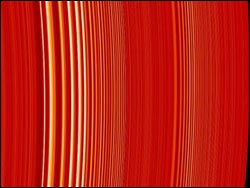Saturn’s ring waves

Saturn’s ring waves
This false-colour image of two density waves in Saturn’s A ring was taken by the NASA/ESA/ASI Cassini-Huygens spacecraft at a distance of 6.8 million kilometres from Saturn.
The image was made from the stellar occultation observed by the Cassini-Huygens Ultraviolet Imaging Spectrograph, and shows a section of rings about 724 kilometres across and the smallest features about half a kilometre across.
Bright areas indicate the denser regions of the rings. The bright bands in the left part of the image are the ’peaks’ of a density wave caused by gravitational stirring of the rings by Saturn’s moon Janus.
A smaller density wave in the right half of the image is produced by the moon Pandora. The Ultraviolet Imaging Spectrograph observed the brightness of the star Xi Ceti as the rings passed in front of it, and the flickering of the starlight was converted into the ring density depicted by the image.
The Cassini-Huygens mission is a co-operative project of NASA, ESA and ASI, the Italian space agency.
Media Contact
More Information:
http://www.esa.intAll latest news from the category: Physics and Astronomy
This area deals with the fundamental laws and building blocks of nature and how they interact, the properties and the behavior of matter, and research into space and time and their structures.
innovations-report provides in-depth reports and articles on subjects such as astrophysics, laser technologies, nuclear, quantum, particle and solid-state physics, nanotechnologies, planetary research and findings (Mars, Venus) and developments related to the Hubble Telescope.
Newest articles

Properties of new materials for microchips
… can now be measured well. Reseachers of Delft University of Technology demonstrated measuring performance properties of ultrathin silicon membranes. Making ever smaller and more powerful chips requires new ultrathin…

Floating solar’s potential
… to support sustainable development by addressing climate, water, and energy goals holistically. A new study published this week in Nature Energy raises the potential for floating solar photovoltaics (FPV)…

Skyrmions move at record speeds
… a step towards the computing of the future. An international research team led by scientists from the CNRS1 has discovered that the magnetic nanobubbles2 known as skyrmions can be…





















